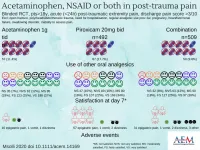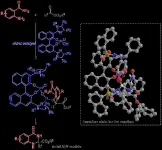In-depth analysis identifies causes and mitigation efforts in COVID-19 cluster
When a cluster of cases emerged at the Brigham this fall, researchers conducted an evaluation to gain a clearer understanding of how SARS-CoV-2 spread and what can be done to prevent future transmissions in hospitals
2021-02-09
(Press-News.org) BOSTON -- Hospitals across the United States have gone to great lengths to implement infection control measures to prevent transmission of SARS-CoV-2. And yet, as the pandemic has unfolded, many health care settings have experienced clusters of cases, with the virus spreading among patients, staff or both. Some clusters have been easily traced back to break rooms and shared meals. But other clusters have been challenging to trace and contain. In September 2020, Brigham and Women's Hospital detected a cluster of infections that would ultimately include 14 patients and 38 staff members. The hospital rapidly activated its incident command structure in order to coordinate a controlled response to contain the cluster. Steps taken included widespread and repeated testing of patients and staff, increased attention to staff wearing eye protection, patients wearing masks, re-emphasis on the principles of safe eating, and the pre-emptive use of precautions in uninfected patients. As part of the response to the cluster, Brigham researchers also conducted a case-control study and whole-genome sequencing to identify factors that may have been involved in the virus's spread as well as the most likely chain of transmission. The lessons gleaned from their data have helped inform infection control efforts at the Brigham and beyond. Findings are published in Annals of Internal Medicine.
"We undertook aggressive efforts to not only contain the cluster but to also try to understand what was driving transmission," said corresponding author Michael Klompas, MD, MPH, an infectious disease physician and hospital epidemiologist in the Brigham's Division of Infectious Diseases. "We pulled out all of the stops to contain this cluster and learned a lot in doing so. We want to share those lessons with our colleagues and the larger health care community."
Researchers were able to trace the cluster back to a patient who tested negative for SARS-CoV-2 on a PCR test both upon admission to the hospital and then on a repeat PCR test 12 hours later. The patient, who had pulmonary disease, received nebulizer treatments, in which liquid medication is delivered as a very fine mist that a patient can breathe in. Staff noted that the patient frequently coughed, did not tolerate a mask and had indistinct speech that led many providers to come near to understand them. The patient likely infected multiple staff members as well as patients who shared a room with the patient.
As evidence of the cluster emerged, investigators used testing and tracing to identify potential cluster-related cases among staff and patients. More than 1,200 staff members were tested for SARS-CoV-2. Eleven of 385 direct contacts of case patients and 27 of 1,072 staff associated with cluster units tested positive for SARS-CoV-2. Fifteen patients and 42 employees met epidemiologic criteria for potentially cluster-related SARS-CoV-2 infection. The team used whole-genome sequencing of samples of the virus to further determine which cases were connected to the cluster. After whole-genome sequencing, 14 patients and 38 employees were included in the cluster.
Researchers conducted a case-control study to better understand what risk factors might have contributed to cases. They evaluated responses from 32 employees with cluster-related infections and 128 uninfected but exposed employees. Infected staff members were more likely to report that they:
were present while case patients received nebulizers;
interacted with SARS-CoV-2 positive staff members in clinical areas;
spent more time exposed to case patients;
were less likely to have worn eye protection.
There were no differences between case and control employees' use of breakrooms and workrooms, amount of time spent in breakrooms and workrooms, or eating within six feet of others.
The researchers also found two cases in which staff members -- a radiology technician and speech and language therapy technician -- reported that they were infected despite wearing proper personal protective equipment, including surgical masks and eye protection.
"Infection control is a multi-faceted task," said Klompas. "These cases are a reminder that masks are just one way to protect oneself; no one measure of protection is perfect. So the best defense against infection is to increase safety through many means as appropriate to a given situation. This includes testing all patients (and retesting 3-4 days after admission or every three days if getting certain procedures), assuring good ventilation, symptom screening, masking oneself, assuring others are masked, using eye protection, maintaining distance whenever possible, minimizing the duration of encounters as clinically appropriate, avoiding crowded spaces, and using good hand hygiene."
Since September 2020, the Brigham and entities across the Mass General Brigham system have put in place additional prevention measures. These include:
repeat testing of admitted patients;
serial testing of every patient undergoing aerosol generating procedures (including nebulizer treatment);
increased messaging about eye protection and the rollout of better-quality eye protection;
increased messaging about the importance of masking for patients.
"Case clusters are the exception rather than the rule in health care settings. But this cluster and others show that if there is a cluster, we can contain it, and that there are multiple proactive measures we can take to decrease the risk of SARS-CoV-2 transmission in hospitals," said Klompas.
INFORMATION:
Paper cited: Klompas M et al. "A SARS-CoV-2 Cluster in an Acute Care Hospital" Annals of Internal Medicine DOI: 10.7326/M20-7567
Brigham Health, a global leader in creating a healthier world, consists of Brigham and Women's Hospital, Brigham and Women's Faulkner Hospital, the Brigham and Women's Physicians Organization and many related facilities and programs. With more than 1,000 inpatient beds, approximately 60,000 inpatient stays and 1.7 million outpatient encounters annually, Brigham Health's 1,200 physicians provide expert care in virtually every medical and surgical specialty to patients locally, regionally and around the world. An international leader in basic, clinical and translational research, Brigham Health has nearly 5,000 scientists, including physician-investigators, renowned biomedical researchers and faculty supported by over $700 million in funding. The Brigham's medical preeminence dates back to 1832, and now, with 19,000 employees, that rich history is the foundation for its commitment to research, innovation, and community. Boston-based Brigham and Women's Hospital is a teaching affiliate of Harvard Medical School and dedicated to educating and training the next generation of health care professionals. For more information, resources, and to follow us on social media, please visit brighamandwomens.org.
ELSE PRESS RELEASES FROM THIS DATE:
2021-02-09
DES PLAINES, IL -- The combination of a high?dose NSAID with paracetamol does not increase the analgesic effect compared to paracetamol alone. Researchers also found that paracetamol alone is superior to high?dose NSAID alone for posttraumatic extremity pain. These are the findings of a study titled Acetaminophen, or nonsteroidal anti-inflammatory drugs, or combination of both analgesics in acute post-trauma pain: a randomized controlled trial, to be published in the February 2021 issue of Academic Emergency Medicine (AEM), a journal of the Society for Academic Emergency Medicine (SAEM).
According to the study, taking into account its superior efficacy ...
2021-02-09
Today, the average American is unlikely to spend time worrying about malaria. Although the disease is commonly perceived to be restricted to other parts of the world, it played a significant role in shaping American history. It even helped turn the tide of the American Revolutionary War by infecting so many British soldiers that General Cornwallis was forced to surrender at Yorktown.
First-year students in a 2019 introductory seminar class led by Erin Mordecai, an assistant professor of biology in the School of Humanities and Sciences (H&S), delved ...
2021-02-09
Samara Polytech chemists investigated the potential anticarcinogenic effects of extracts obtained from plant materials of lingonberry, raspberry, black chokeberry, grapes, Krasnodar green tea, ginseng, fireweed and coffee, and also evaluated their effect on the growth and viability of colon cancer cells. The research was carried out within the framework of the state assignment for fundamental research No. 0778-2020-0005, its results were published Dec. 29, 2020 in the journal Proceedings of Universities. Applied Chemistry and Biotechnology (DOI: https://doi.org/10.21285/2227-2925-2020-10-4-613-626).
Prevention is the most cost-effective and long-term strategy for controlling this disease. It is now well known ...
2021-02-09
A lot of our medicines and other bioactive drugs are based on chemical structures called "enantiomers"-- molecules that are mirror images of each other and are non-superimposable. Notable among them are chiral N,N-acetals contained in diuretic drugs like bendroflumethiazide and thiabutazide, used to treat high blood pressure and edema. Because an enantiomer and its mirror image version often have different biological activities, with only one of them having pharmacological utility, an "enantioselective" or asymmetric synthesis yielding the desired enantiomer in greater amounts is highly desirable.
In the case of N,N-acetals, several studies have demonstrated their enantioselective preparation from aldehydes, aldimines, or enamines. However, in all these cases, ...
2021-02-09
CLEVELAND (Feb. 9)--A study led by Case Western Reserve University researchers found that patients with dementia were at a significantly increased risk for COVID-19--and the risk was higher still for African Americans with dementia.
Reviewing electronic health records of 61.9 million adults in the United States, researchers found the risk of contracting COVID-19 was twice as high for patients with dementia than for those without it--while among those with dementia, African Americans had close to three times the risk of being infected with COVID-19 as Caucasians did.
In addition, patients with dementia who ...
2021-02-09
KEY STUDY FINDINGS INCLUDE:
2.9% of U.S. adults report a current peanut allergy.
About one in six adults with a peanut allergy developed it after age 18.
Approximately one in five adults with peanut allergy report visiting the emergency department for food allergy treatment each year.
Patients who developed their peanut allergy during adulthood are less likely to report having an epinephrine auto-injector prescription than those who developed their peanut allergy during childhood, despite similar frequencies of severe reactions among both groups.
CHICAGO --- Peanut allergy affects at least 4.5 million adults in the U.S., many of whom report developing their ...
2021-02-09
Researchers at Baylor College of Medicine and other institutions have identified a novel strategy that can eliminate bacteria in a specific location before they cause an infection. The strategy uses a phage, a virus that infects and destroys bacteria, that can specifically locate in the same place the bacteria live in the gastrointestinal tract. The proximity between phage and bacteria facilitates the phage's attack and subsequent elimination of the bacteria.
This strategy has the potential of becoming a game changer in the fight against antibiotic-resistant bacteria ...
2021-02-09
DALLAS, Feb. 9, 2021 -- Participants in a two-year, lifestyle intervention/weight-loss program provided through health coaches at their primary care center were able to lower their blood sugar and improve their cholesterol levels, according to new research published today in the American Heart Association's flagship journal Circulation Journal. Researchers with the PROmoting Successful Weight Loss in Primary CarE in Louisiana (PROPEL) Trial reported previously that participants also reduced body weight by an average of 5% and note that patients who lost more weight experienced greater improvements in their heart disease risk factors.
"Our results demonstrate lifestyle intervention and weight-loss programs can be successful for people in underserved, low-income ...
2021-02-09
DALLAS, Feb. 9, 2021 -- Dietary information from three large, well-known heart disease studies suggests drinking one or more cups of caffeinated coffee may reduce heart failure risk, according to research published today in Circulation: Heart Failure, an American Heart Association journal.
Coronary artery disease, heart failure and stroke are among the top causes of death from heart disease in the U.S. "While smoking, age and high blood pressure are among the most well-known heart disease risk factors, unidentified risk factors for heart disease remain," according to David P. Kao, M.D., senior author of the study, assistant professor of cardiology and medical director at the Colorado Center for Personalized Medicine at the University of Colorado School of Medicine ...
2021-02-09
In 2017, a widely cited study used statistical tools to model how likely the world is to meet the Paris Agreement global temperature targets. The analysis found that on current trends, the planet had only a 5% chance of staying below 2 degrees Celsius warming this century -- the international climate treaty's supposed goal.
Now, the same authors have used their tools to ask: What emissions cuts would actually be required to meet the goal of 2 C warming, considered a threshold for climate stability and climate-related risks such as excessive heat, drought, extreme weather and sea level rise?
The University of Washington study finds that emissions reductions about 80% more ambitious than those in the Paris Agreement, or an average of 1.8% drop in emissions per year rather than 1% ...
LAST 30 PRESS RELEASES:
[Press-News.org] In-depth analysis identifies causes and mitigation efforts in COVID-19 cluster
When a cluster of cases emerged at the Brigham this fall, researchers conducted an evaluation to gain a clearer understanding of how SARS-CoV-2 spread and what can be done to prevent future transmissions in hospitals


